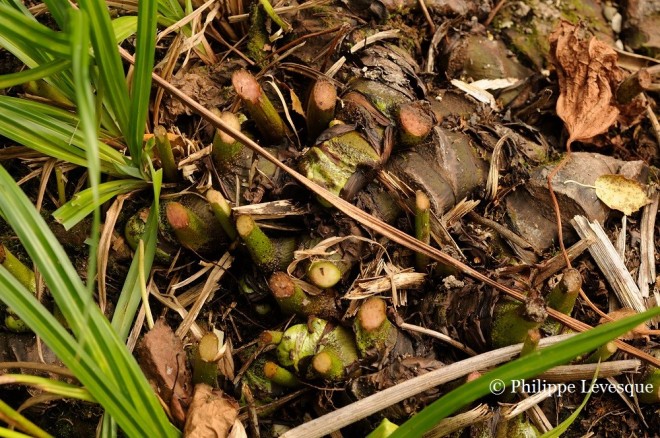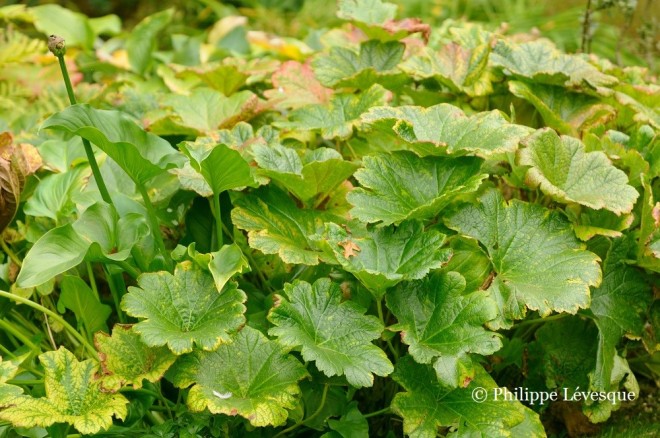I was walking in Salzburg University’ s small but quaint botanical garden a while ago when I stumbled upon two young gardeners (students?) cutting back a big patch of Darmera peltata. My initial thought was why destroy such a beautifully established plantation, but as kept walking along the waterway that separates the garden in two, I realized that it had maybe taken over too much ground and needed to give space over to others. Darmera is not an invasive plant but it certainly knows how to fight its ground. It is very competitive and precious little can dislodge it once established. I left a clump unattended for more than 10 years in a field and when I went back, nothing had succeeded in growing through it, not even tree saplings.

This giant saxifrage used to be known under the descriptive name of Peltiphyllum (from the Greek peltos, shield, and phyllos, leaf) for its beautiful round plate-size leaves (glossy and slightly concave, unlike the similar but matte and convex Astilboides). It had just changed name when I encountered it for the first time as a burgeoning gardener twenty years ago.
Darmera is a great bog plant that offers a good contrasting shape to reeds, irises, cattails and other linear marsh dwellers. It is very easy to grow and although it relishes mud (even if it won’t survive with its rhizomes submerged in water), it will grow happily in ordinary garden soil. It will grow in full sun if the soil is damp, but prefers shade during the hottest part of the day. Although the plant is amenable to drier conditions, the foliage can start to look tired early on and flowering is diminished considerably. Darmera is normally grown as a foliage plant and advertised as such, but under auspicious conditions flowering is abundant and a beautiful sight.
 Early in spring, its large pink umbels emerge from the mud on tall crimson stalks. It is a welcome burst of life at a time of year when little else is out in the bog garden. I have been hopeful to find a white form somewhere but thus far none has materialized. Perhaps if one went scourging its natural habitat on the West Coast of America in April, one might get lucky. I haven’t come across a variegated sport either. The only variation I am aware is of a dainty dwarf form aptly called ‘Nana’. I cannot establish how it originated but it has been around for a long time in the United Kingdom. Despite its long period of cultivation, ‘Nana’ remains a rarity as it is a very slow growing plant. Unlike the species, it needs a rich humid spot to do well and does not take kindly to dry conditions. Yet ‘Nana’ is a darling plant that fills a niche since most wetland plants are too aggressive and/or invasive for small ponds. Its foliage also takes on colourful shades in the autumn more readily than the species and it is often ablaze with golden yellow and red in October here.
Early in spring, its large pink umbels emerge from the mud on tall crimson stalks. It is a welcome burst of life at a time of year when little else is out in the bog garden. I have been hopeful to find a white form somewhere but thus far none has materialized. Perhaps if one went scourging its natural habitat on the West Coast of America in April, one might get lucky. I haven’t come across a variegated sport either. The only variation I am aware is of a dainty dwarf form aptly called ‘Nana’. I cannot establish how it originated but it has been around for a long time in the United Kingdom. Despite its long period of cultivation, ‘Nana’ remains a rarity as it is a very slow growing plant. Unlike the species, it needs a rich humid spot to do well and does not take kindly to dry conditions. Yet ‘Nana’ is a darling plant that fills a niche since most wetland plants are too aggressive and/or invasive for small ponds. Its foliage also takes on colourful shades in the autumn more readily than the species and it is often ablaze with golden yellow and red in October here.

Both the species and its dwarf form will take a few years to reach their full potential. One can expect the foliage to be much shorter and smaller the first year and sometimes even the second year after planting. Darmera is not a plant that needs dividing often, mine has been in the same place for nearly 20 years and retains all its vigor. Some books say that it gets thin in the center after a while, but that’s not my experience or what I have observed from other gardens. New rhizomes seem to fill gaps made by old ones that die out and the clumps remain dense for very many years.

As I looked at the Darmera removal operation in Salzburg, a second thought came to my mind. These gardeners were going to need a lot of will power to dig this network of rhizomes after they finish cutting back the foliage. They did not seem very enthusiastic, let’s hope there was machinery available nearby.
~ Philippe Lévesque


You must be logged in to post a comment.